The Radeon HD 7970 Reprise: PCIe Bandwidth, Overclocking, & The State Of Anti-Aliasing
by Ryan Smith on January 27, 2012 4:30 PM EST- Posted in
- GPUs
- AMD
- Radeon
- Radeon HD 7000
Overclocking Revisited
While we’ve taken a look at overclocking the Radeon HD 7970 in our review of XFX’s Radeon HD 7970 Black Edition Double Dissipation, that was a look at XFX’s custom cooled card. We’ve had a number of requests for overclocking performance on our reference card, so we’ve gone ahead and done that.
In the meantime though a couple interesting facts have come to light. While both our reference card and our XFX card ran at 1.175v, it turns out that this is not the only voltage the 7970 ships at. Retail buyers have reported receiving cards that run at 1.112v and 1.05v, and Alexey Nicolaychuk (aka Unwinder), the author of MSI Afterburner, has discovered that there’s a 4th voltage according to the fuses on Tahiti: 1.025v. 1.025v has not been seen in any retail cards so far, and it’s most likely a bin that’s reserved for future products (e.g. the eventual 7990), while out of the remaining 3 voltages 1.175 appears to be the most common.
| Radeon HD 7900 Series Voltages | ||||
| Ref 7970 Load | Ref 7970 Idle | XFX 7970 Black Edition DD | ||
| 1.17v | 0.85v | 1.17v | ||
In any case, in overclocking our reference 7970 we’ve found that the results are very close to our XFX 7970. Whereas our XFX 7970 could hit 1125MHz without overvolting, our reference 7970 topped out at a flat 1100MHz. Meanwhile our memory speeds reached 6.3GHz before performance began to dip, which was the same point we reached on the XFX 7970 and not at all surprising since both boards use the same PCB.
Overall this represents a 175MHz (18%) core overclock and 800MHz (15%) memory overclock over the stock clocks of our reference 7970. As we’ll see, since this is being done without overvolting the power consumption hit (and all consequences thereof) from this is minimal to non-existent, making this a rather sizable free overclock.
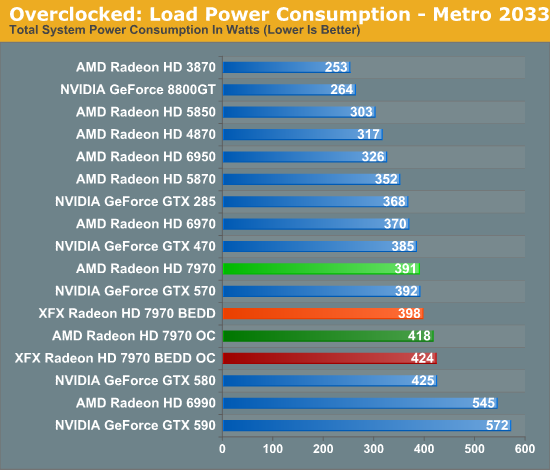
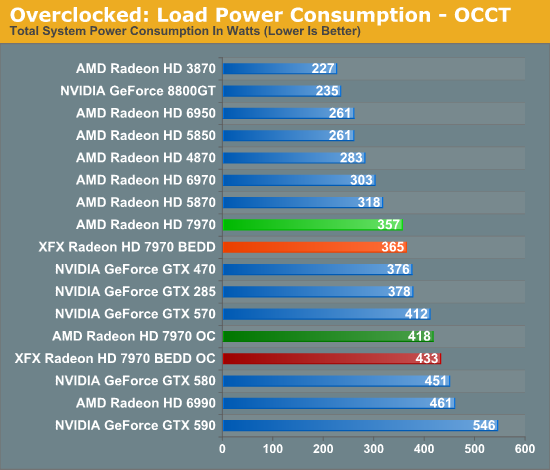
Taking a quick look at power/temp/noise, we see that the increase in load power is consistent with our earlier results with the XFX 7970. Under Metro the power increase is largely the CPU ramping up to feed the now-faster 7970. While under OCCT we’re seeing the consequence of increasing the PowerTune limit so that we don’t inadvertently throttle performance when gaming.
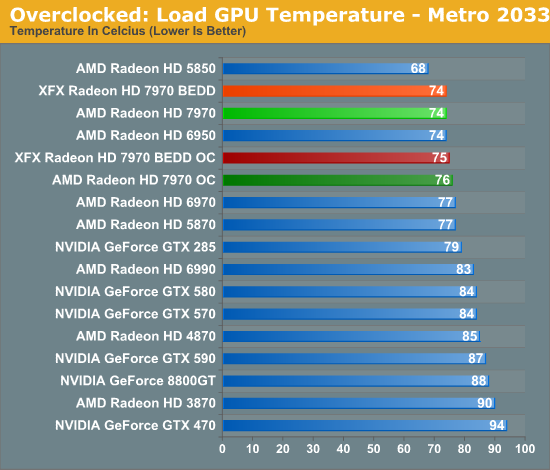
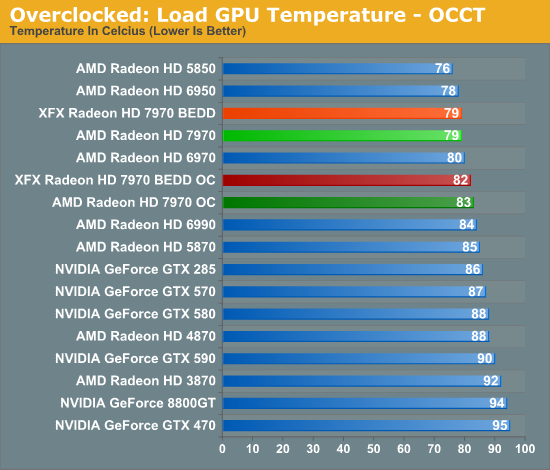
With almost no increase in GPU power consumption while gaming, temperatures hold steady. This translates to a 2C increase in temperatures, while under OCCT the difference is 4C.
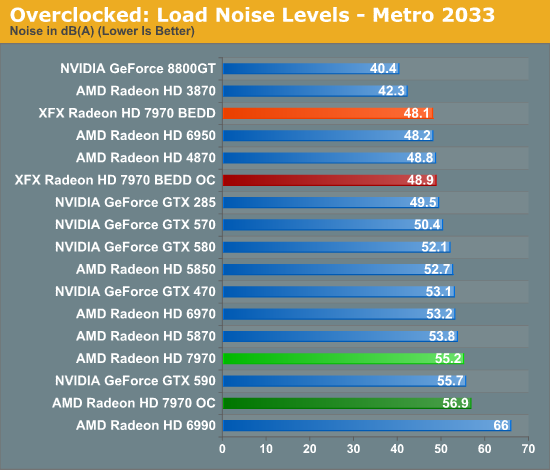

Finally, as with temperature, noise only ever so slightly creeps up. Unfortunately for most users, AMD’s already aggressive fan profile makes this relatively loud card just a bit louder yet; the temperatures are fantastic, but the noise less so. Things look even worse under OCCT, but again this is a pathological test with PowerTune increased to 300W.
Meanwhile gaming performance is where you’d expect it to be for a card with this degree of an overclock. As most tests scale very well with the increase in the core clock virtually all of our games are 15-20% faster over a reference 7970. Whereas compared to the XFX 7970, at 98% of the XFX 7970’s overclock, our overclocked reference 7970 is only a couple percent behind the XFX card and barely outside the margin of error of most tests.
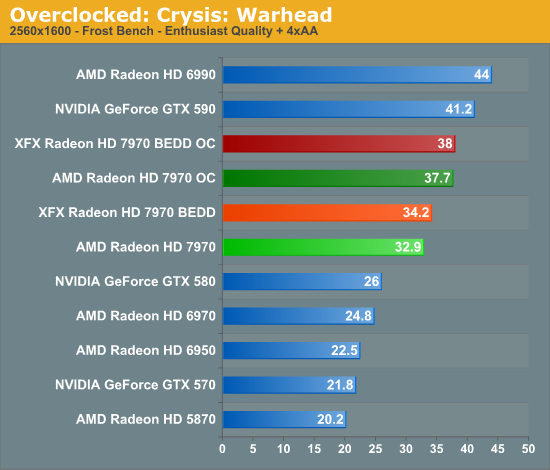
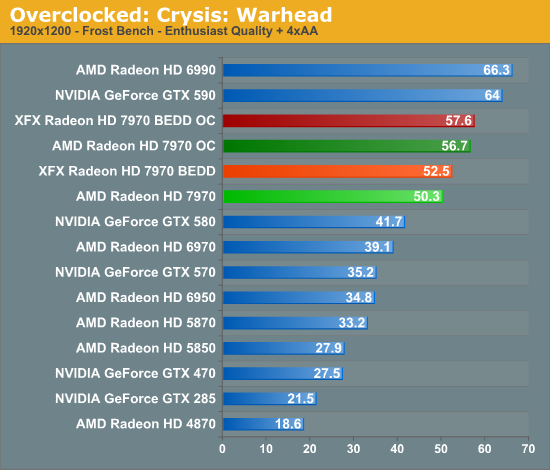

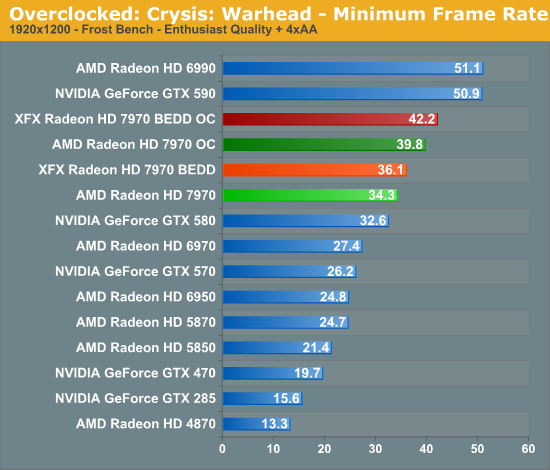
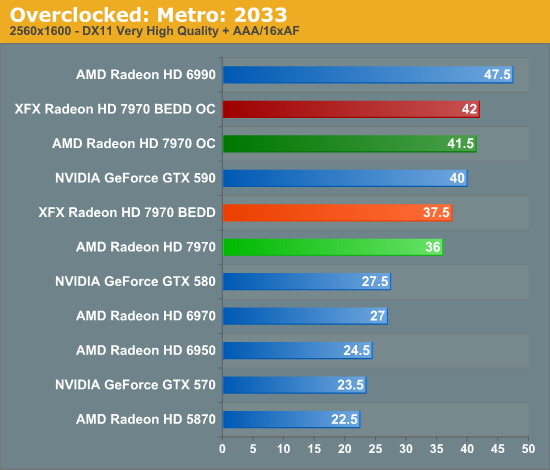

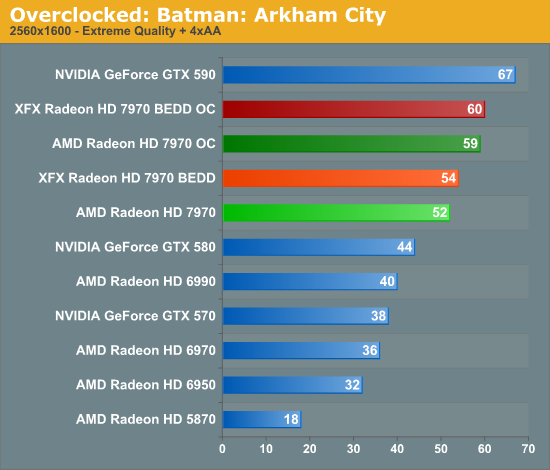
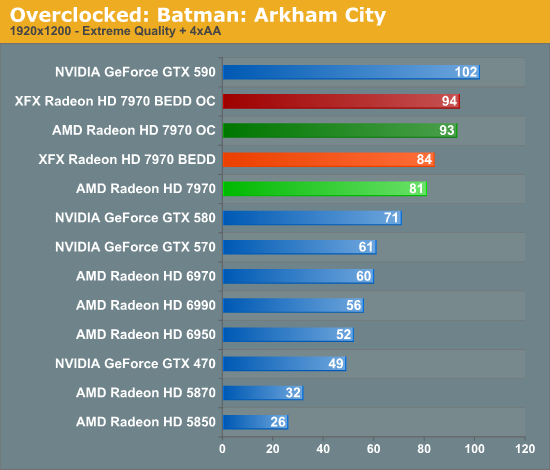
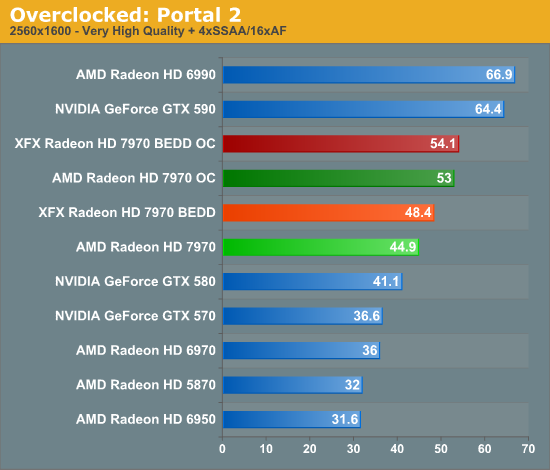
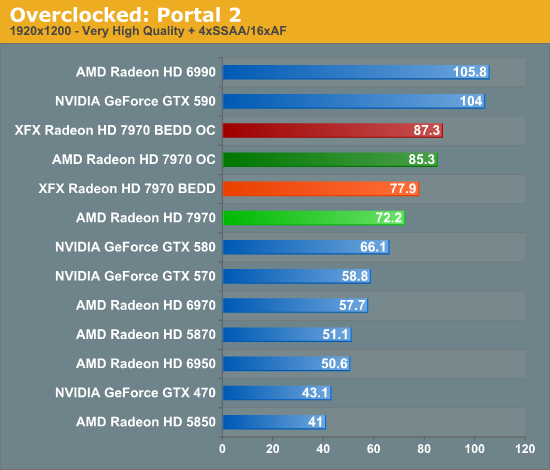
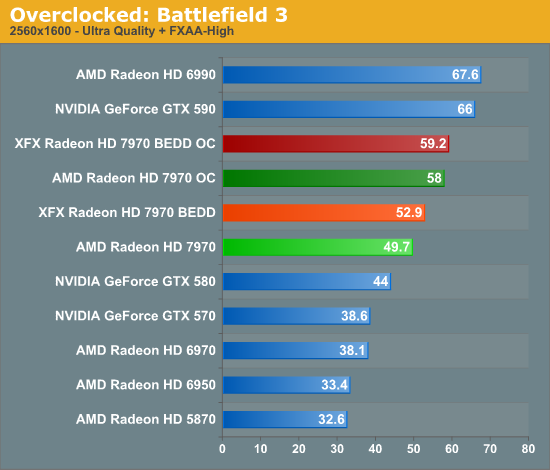
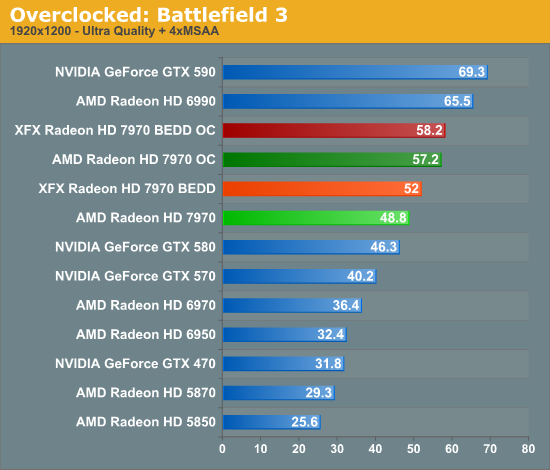
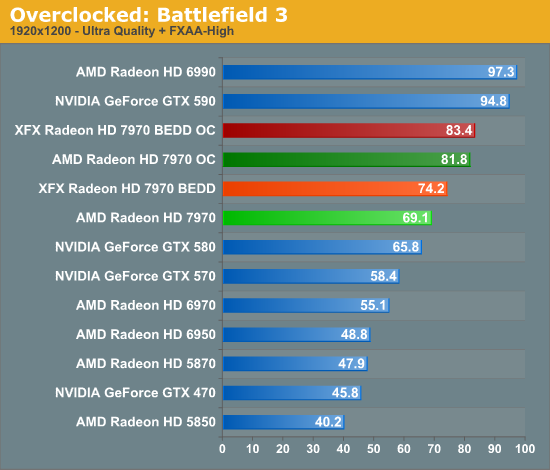
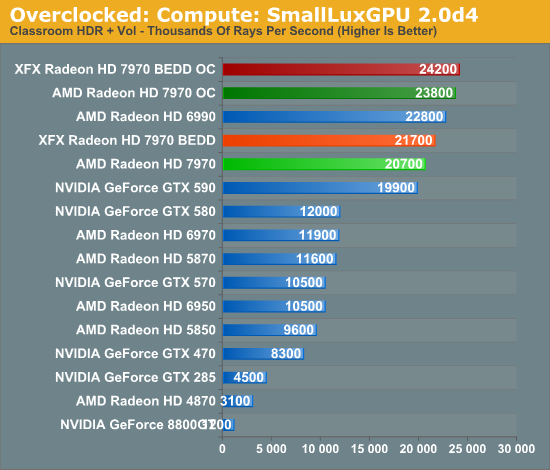
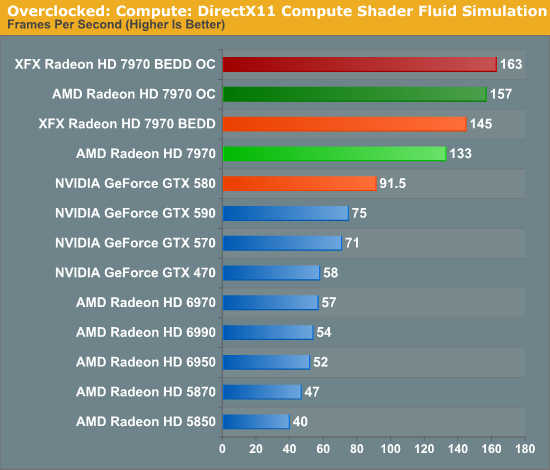
All things considered, outside of warranty restrictions there seems to be very little reason not to overclock the 7970 on its default voltage. Even a conservative overclock of 1050MHz would add 13% to the core clocks (and as a result performance in virtually all GPU-limited scenarios), which is a big enough leap in performance to justify spending the time setting up and testing the overclock. By not raising the core voltage there’s effectively no power/noise tradeoff and this seems to be achievable by virtually every 7970, making this a freebie overclock the likes of which we’re more accustomed to seeing on high-end CPUs than we are flagship GPUs.










47 Comments
View All Comments
annnonymouscoward - Sunday, January 29, 2012 - link
Thanks for measuring the PCIe bandwidth results--this is good data. If I may nitpick: please follow SI, and abbreviate seconds with "s" and volts with "V".MGSsancho - Monday, January 30, 2012 - link
This information also makes me dreams of the unannounced xbox. Is this compatible with the current e-dram related hardware AA on the xbox360? Another question, could this possibly help a mythical gen gaming console to do more in hardware?Th-z - Monday, January 30, 2012 - link
I like the visual of the demo, surface materials, lighting, and shadows all look natural and refreshing. It has the quality of offline renderer. It's much better than most games out there today, which all surfaces look alike, overly shiny surfaces, unnatural glow, and general blurriness. I know a lot has to do with hardware limitation of consoles and developers like to use excessive post process to hide it, but the visual is getting old.The demo shows how software (AMD's new forward rendering technique) targets a specific hardware can produces stunning results.
MySchizoBuddy - Monday, March 5, 2012 - link
How come you guys don't do stability testing. run the cards for 48 hours straight using folding@home and see what happens. Also do testing of ECC memory and how error prone the card is.I understand the authors of anandtech hardly ever read comments section so if anyone knows how do I get my wish list to anandtech please let me know.
N1bble - Tuesday, March 13, 2012 - link
I've got an Asus p5k pro motherboard with PCIe 1.0 or 1.1. (GPU-Z says 1.1, manual says simply PCI-e x16)Does this test prove that the cards will work on PCIe 1.x or could there be other issues since PCIe 3.0 isn't fully compatible to 1.x?
mudy - Monday, April 23, 2012 - link
... I see that you have stated the consequences as to what happens to the PCIe lanes if you use a non-IVB processors but not, what happens if you have a pcie 2.0 compliant GPU and that too in SLI! Also an article on how the lane would be distributed under all scenarios like, pcie 2.0: Single GPU, dual/triple GPU; pcie 3.0: single/dual/triple GPUs!!Harry Lloyd - Sunday, February 24, 2013 - link
I am very excited about this new technique for calculating lighting in a forward renderer. Deferred MSAA is a disaster, and postAA gives mediocre results, so I really hope we are going to see a move back to forward rendering in the next iteration of engines, in 2-3 years.